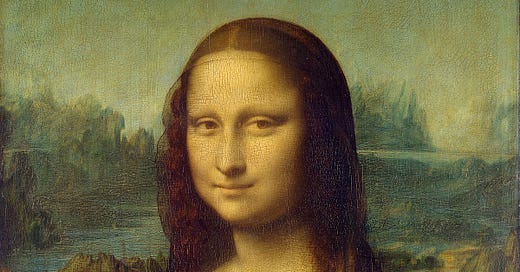Buongiorno (as Leonardo would say),
I finished reading Leonardo da Vinci’s biography, and it deserves an entire edition.
In other news, I took the calculus proficiency exam, will return to my dorm, and the second semester of college is here.
Andiamo, Andiamo Leonardo is waiting for us.
Curiosities on Leonardo da Vinci 🖌👨🔬🔢
All quotes can be attributed to Walter Isaacson, “Leonardo da Vinci.”
1. Curious for Curiosity’s Sake
This newsletter can be renamed after da Vinci because this guy was so curious.
His curiosity impelled him to become among the handful of people in history who tried to know all there was to know about everything that could be known.
His curiosity is what made him a “genius.”
Leonardo had almost no schooling and could barely read Latin or do long division. His genius was of the type we can understand, even take lessons from.
It was based on skills we can aspire to improve in ourselves, such as curiosity and intense observation. He had an imagination so excitable that it flirted with the edges of fantasy, which is also something we can try to preserve in ourselves and indulge in our children.”
One of the main themes of the book was that we can all try to be more curious, and claim back our inner child-like curiosity because there comes a point where we stop asking ourselves questions like, “Why is the sky blue?” or “How do airplanes work?”
I bet most people don’t know the answers to these questions.
To stop being curious is to stop fully living. To stop fully living is to be buried alive.
2. Mona Lisa: His Curiosity Harmonized in One Work
“His insatiable curiosity, his restless leaps from one subject to another, have been harmonized in a single work,” Kenneth Clark wrote of the Mona Lisa.
The science, the pictorial skill, the obsession with nature, the psychological insight are all there, and so perfectly balanced that at first we are hardly aware of them.
I saw the Mona Lisa in person, and even though it’s behind thick glasses, and security protocols, you can feel da Vinci’s mastery of human emotion.
When you look at the painting, you feel a different feeling every time. “What’s she smiling at?” or “Is she sad?” or “Does she need help?” or “Wait, did she just move?” or “What is she thinking?”
Before reading this book, I didn’t appreciate art as much as I do now.
To paint a “simple” painting, there’s an immense amount of background information and mastery of many subjects such as art, psychology, science, anatomy, chemistry, physics, math, and engineering.
3. Mystery Behind Curiosity
as Kenneth Clark noted, “Mystery to Leonardo was a shadow, a smile and a finger pointing into darkness.”
Needless to say, Leonardo da Vinci was obsessed with the uncertainties of mystery.
One of his best works is the Lady with an Ermine. She has a mysterious smile and an ermine that is…What is the ermine even doing?
Leonardo loved puns, including visual ones, and just as the juniper plays on Ginevra de’ Benci’s name, so does the ermine (in Greek, galée) evoke the name of Gallerani. A white ermine also was a symbol of purity. “The ermine would die rather than soil itself,” Leonardo wrote in one of his bestiary entries.
The twisting head and body, a form of contrapposto, had become one of Leonardo’s lively signatures, such as in the angel of Virgin of the Rocks. The writhing but poised ermine mimics Cecilia’s movement, spiraling in synch with her. Both Cecilia’s wrist and that of the ermine are gently cocked, protectively.
Their shared vitality makes it seem that they are not merely characters in a picture but players in a real-life situation, part of a scene involving a third participant.
4. A Replicable Genius
I read this book because I wanted to understand the principles that made him Leonardo, learn from his mistakes, and draw lessons to replicate in my life.
Below is one of my favorite quotes from the book.
What made Leonardo a genius, what set him apart from people who are merely extraordinarily smart, was creativity, the ability to apply imagination to intellect. His facility for combining observation with fantasy allowed him, like other creative geniuses, to make unexpected leaps that related things seen to things unseen.
“Talent hits a target that no one else can hit,” wrote the German philosopher Arthur Schopenhauer. “Genius hits a target no one else can see.”
Because they “think different,” creative masterminds are sometimes considered misfits, but in the words that Steve Jobs helped craft for an Apple advertisement, “While some may see them as the crazy ones, we see genius. Because the people who are crazy enough to think they can change the world are the ones who do.”
5. Most Important Lesson from da Vinci
Above all, Leonardo’s relentless curiosity and experimentation should remind us of the importance of instilling, in both ourselves and our children, not just received knowledge but a willingness to question it—to be imaginative and, like talented misfits and rebels in any era, to think different.
In a world where we don’t know what’s true anymore, we need to strive to be independent thinkers who are willing to think for themselves, and to think different.
Do you know a curious person?
Can you think of someone who will be inspired by da Vinci?
Share this post with them. They will thank you.
How would you rate this week's newsletter? 🤔🧮
Ciao,
Juan David Campolargo





